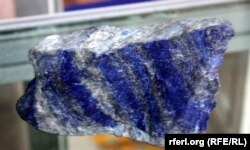In recent years, Afghanistan has been cheated of hundreds of millions of dollars in revenues and profits through the illegal mining of one of its precious stones: lapis lazuli.
RFE/RL's Gandhara website has learned that after deceiving the central government of revenues from more than 2,000 metric tons of the deep blue stones last year, another 5,000 metric tons of illegally excavated lapis is being stored in a remote northeastern province where it was mined.
Two recent letters sent to the Afghan president and leaked to Gandhara detail the extent of the corruption and mafia-style monopoly of warlords and corrupt officials over the illegal mining, which undermines government efforts to improve the country's fledgling economy and combat graft.
"A fraudulent scheme was engineered by a number of traders, miners, warlords and corrupt government officials," said a recent letter by the U.S Special Inspector General for Afghanistan Reconstruction (SIGAR) to Afghan President Ashraf Ghani. "[In this scheme,] the value and quality of the lapis was significantly undervalued, thus minimizing the amount of royalties that were assessed and collected by [the] Government of the Islamic Republic of Afghanistan for the lapis."
The letter, written earlier this year and obtained by Gandhara from an Afghan government source, says Kabul only received $230,000 for more than 2,000 metric tons of lapis, which is valued between $60 million and $120 million.
According to the U.S. Geological Survey, Afghanistan has nearly $1 trillion in untapped mineral deposits, enough to fundamentally alter the impoverished nation's future. Kabul, however, has failed to put a stop to illegal mining despite the country's supreme law establishing that "mines and other subterranean resources" are property of the state liable to be regulated by law.
The SIGAR letter says 5,000 metric tons of lapis are now being stored in the Barak and Jurm districts of northeastern Badakhshan Province, where the stone -- used in jewelry and ornaments -- has been mined since antiquity.
"It is conservatively estimated that this lapis has a value ranging from $150 million to $300 million," the letter said.
The letter says that "warlords and corrupt officials" might be pressuring a three-member government team tasked with valuing the load to falsify assessment of the true value of these lapis.
"As in the previous instance in early 2015, it is believed that these corrupt individuals will fraudulently attempt to significantly undervalue the value of the lapis," the SIGAR letter said. "If successful, this corrupt undervaluing of the lapis will result in the loss of tens of millions of dollars in royalties and revenues that should be rightfully paid to the Afghan government, which would be to the benefit of all citizens of Afghanistan."
The claims made by SIGAR are backed by a memo to the Afghan president by his adviser on mines.
"Unfortunately, we are still seeing known mafia groups robbing this precious resource with the help of government organizations," the January memo by Mohammad Yousaf Pashtun noted. "Given the presence of mafia and extensive government corruption, it is now very difficult to control the graft in this sector."
The letter claims that more than 1,000 tons of lapis were smuggled from mines in Badakhshan's Keran-wa-Menjan district to neighboring China without any payment of government taxes.
The memo identifies Commander Alhaj Malik from Panjshir, a province bordering Badakhshan, as a prominent figure in controlling the illegal lapis mining. "His son [not named] is the head of the National Directorate of Security (the Afghan spy agency) in Badakhshan," the memo said. "He informs his father of all orders given to the provincial authorities from the central government to prevent illegal mining, which helps him to mitigate them."
Malik could not be reached for comments.
In Badakhshan, however, provincial authorities claim they are in possession of the lapis load. "The stock is now under the control of provincial authorities, and we have sent a letter to the National Security Council (NSC) to make the final decision whether to release the stock or seize it," Deputy Governor Gul Muhammad Baidar said.
He revealed the NSC ordered the release of 2,000 tons last year after locals petitioned officials in Kabul.
A spokesman for the NSC, however, refused to comment, saying he did not have enough information about the issue.
Khudainoor Mandarkhail, a veteran mining expert and a senior member of the Afghan president's advisory team on mining, criticized the NSC for allowing the huge stock of illegally extracted lapis to be sold in return for such minuscule revenues.
"It was unlawful to tax illegally extracted minerals. Illegal extraction is a crime, and the perpetrators should be sent to jail," he said.
Several sources in Badakhshan confirmed that local commanders, corrupt government officials, insurgents, and members of criminal networks continue to extract and smuggle lapis and other minerals from the region that shares borders with China, Tajikistan, and Pakistan.
Presidential adviser Pashtun recommends that the best course for the government now is to allow lapis exports through Kabul alone.
"We should confiscate the best quality illegally excavated lapis and store it in Afghanistan's central bank," he wrote.
as/fg








